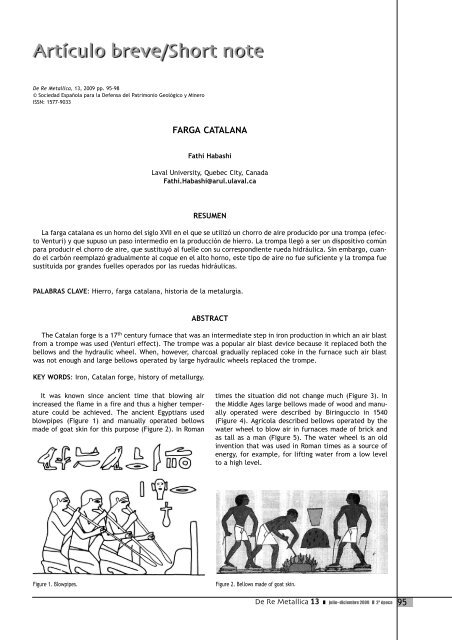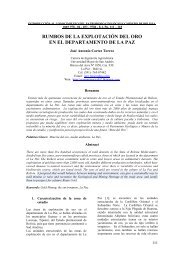Fathi Habashi - Sociedad Española para la Defensa del Patrimonio ...
Fathi Habashi - Sociedad Española para la Defensa del Patrimonio ...
Fathi Habashi - Sociedad Española para la Defensa del Patrimonio ...
You also want an ePaper? Increase the reach of your titles
YUMPU automatically turns print PDFs into web optimized ePapers that Google loves.
De Re Metallica, 13, 2009 pp. 95-98<br />
© <strong>Sociedad</strong> <strong>Españo<strong>la</strong></strong> <strong>para</strong> <strong>la</strong> <strong>Defensa</strong> <strong>del</strong> <strong>Patrimonio</strong> Geológico y Minero<br />
ISSN: 1577-9033<br />
FARGA CATALANA<br />
<strong>Fathi</strong> <strong>Habashi</strong><br />
Laval University, Quebec City, Canada<br />
<strong>Fathi</strong>.<strong>Habashi</strong>@arul.u<strong>la</strong>val.ca<br />
RESUMEN<br />
La farga cata<strong>la</strong>na es un horno <strong>del</strong> siglo XVII en el que se utilizó un chorro de aire producido por una trompa (efecto<br />
Venturi) y que supuso un paso intermedio en <strong>la</strong> producción de hierro. La trompa llegó a ser un dispositivo común<br />
<strong>para</strong> producir el chorro de aire, que sustituyó al fuelle con su correspondiente rueda hidráulica. Sin embargo, cuando<br />
el carbón reemp<strong>la</strong>zó gradualmente al coque en el alto horno, este tipo de aire no fue suficiente y <strong>la</strong> trompa fue<br />
sustituida por grandes fuelles operados por <strong>la</strong>s ruedas hidráulicas.<br />
PALABRAS CLAVE: Hierro, farga cata<strong>la</strong>na, historia de <strong>la</strong> metalurgia.<br />
ABSTRACT<br />
The Cata<strong>la</strong>n forge is a 17 th century furnace that was an intermediate step in iron production in which an air b<strong>la</strong>st<br />
from a trompe was used (Venturi effect). The trompe was a popu<strong>la</strong>r air b<strong>la</strong>st device because it rep<strong>la</strong>ced both the<br />
bellows and the hydraulic wheel. When, however, charcoal gradually rep<strong>la</strong>ced coke in the furnace such air b<strong>la</strong>st<br />
was not enough and <strong>la</strong>rge bellows operated by <strong>la</strong>rge hydraulic wheels rep<strong>la</strong>ced the trompe.<br />
KEY WORDS: Iron, Cata<strong>la</strong>n forge, history of metallurgy.<br />
It was known since ancient time that blowing air<br />
increased the f<strong>la</strong>me in a fire and thus a higher temperature<br />
could be achieved. The ancient Egyptians used<br />
blowpipes (Figure 1) and manually operated bellows<br />
made of goat skin for this purpose (Figure 2). In Roman<br />
Figure 1. Blowpipes. Figure 2. Bellows made of goat skin.<br />
times the situation did not change much (Figure 3). In<br />
the Middle Ages <strong>la</strong>rge bellows made of wood and manually<br />
operated were described by Biringuccio in 1540<br />
(Figure 4). Agrico<strong>la</strong> described bellows operated by the<br />
water wheel to blow air in furnaces made of brick and<br />
as tall as a man (Figure 5). The water wheel is an old<br />
invention that was used in Roman times as a source of<br />
energy, for example, for lifting water from a low level<br />
to a high level.<br />
De Re Metallica 13 julio–diciembre 2009 2ª época 95
96<br />
Figure 3. Iron production in Roman times. Note the foot-operated bellows and the charcoal kiln at the left.<br />
Figure 4. Manually-operated bellows (Biringuccio, 1540).<br />
Figure 5. Water wheel operating bellows (Agrico<strong>la</strong>, 1555).<br />
A new invention appeared in the Middle Ages when it<br />
was found that the system of water wheel and bellow<br />
can be rep<strong>la</strong>ced by a simple device known as trompe, or<br />
hydraulic air b<strong>la</strong>st, that did not need a moving part (Figure<br />
6 and 7). This device was first described in 1589 by<br />
De Re Metallica 13 julio–diciembre 2009 2ª época<br />
the Neapolitan scho<strong>la</strong>r Giambattista <strong>del</strong><strong>la</strong> Porta (1535-<br />
1615 ) (Figure 8) in his Magiæ Naturalis libri XX (English<br />
trans<strong>la</strong>tion London, 1658). This new system was introduced<br />
on <strong>la</strong>rge scale in the vil<strong>la</strong>ge of Ripoll, province of<br />
Gerona in Catalonia, Kingdom of Aragon in Spain around<br />
Figure 6. Principle of the trompe.
Figure 7. Farga Cata<strong>la</strong>na.<br />
Figure 9. Large water wheel to activate bellows.<br />
Figure 8. Giambattista <strong>del</strong><strong>la</strong> Porta (1535-1615).<br />
1650. It became known as Farga Cata<strong>la</strong>na, i.e., the<br />
Cata<strong>la</strong>n forge. The water from a river was caught in a<br />
small reservoir just above the furnace, and after the furnace<br />
was lighted the water was permitted to run down<br />
a pipe at the back of the furnace. It made use of the<br />
aspirating of a falling column of water inside a tube, to<br />
draw air in through holes in the sides of the tube near its<br />
top, and expel the air into a<br />
closed chamber at the bottom.<br />
The air was introduced<br />
to the furnace from this<br />
chamber by means of a pipe.<br />
The air flow acted as a constant<br />
b<strong>la</strong>st. Ripoll enjoyed a<br />
reputation throughout<br />
Europe for the production of<br />
firearms.<br />
However, at the end of<br />
the 18 th century, the need<br />
for increased iron production<br />
and the switch from charcoal<br />
to coke in furnaces necessitated<br />
the construction of<br />
<strong>la</strong>rger furnaces. The air<br />
blown by the trompe was too<br />
weak for such furnaces. As a<br />
result, <strong>la</strong>rge water-wheels<br />
were constructed to drive<br />
<strong>la</strong>rge bellows to obtain higher<br />
pressures and higher air<br />
flow (Figure 9). This gradually<br />
rep<strong>la</strong>ced the Cata<strong>la</strong>n forge<br />
which also fell into decline<br />
due to the exhaustion of the<br />
local charcoal supplies. All<br />
this came to an end when<br />
the steam engine was introduced<br />
to operate blowers to<br />
introduce air in the furnace<br />
(Figure 10).<br />
De Re Metallica 13 julio–diciembre 2009 2ª época 97
98<br />
Figure 10. The steam engine rep<strong>la</strong>ced the trompe as well as the water wheel.<br />
The Pyrenees region is rich in iron ore and has a long<br />
iron making tradition. This activity has produced economic<br />
wealth dating from the beginning of the 17 th century<br />
to the end of the 19 th century. Forestry, mining, and<br />
processing factories have left substantial traces as much<br />
in the <strong>la</strong>ndscape. The Iron Route set up in 1996 offers<br />
visitors the opportunity to explore the p<strong>la</strong>ces connected<br />
to the process of obtaining and transforming iron. The<br />
objectives of the project <strong>la</strong>unched in the 1970s by the<br />
Andorran government were to make the public aware of<br />
all the different aspects of this heritage: the mines,<br />
charcoal kilns and ironworks, as well as miner’s and<br />
De Re Metallica 13 julio–diciembre 2009 2ª época<br />
ironworker’s homes and some typical features of architecture<br />
of ironworks.<br />
SUGGESTED READINGS<br />
<strong>Habashi</strong>, F. 2006. Readings in Historical Metallurgy, Volume 1.<br />
Changing Technology in Extractive Metallurgy, Métallurgie<br />
Extractive Québec, Québec City, 800 pp.<br />
Tomás i Morera, E. (Ed.) 1995. La farga cata<strong>la</strong>na en el marc de<br />
l’arqueologia siderúrgica. Ministry of Social Affairs and Culture,<br />
Government of Andorra.
















